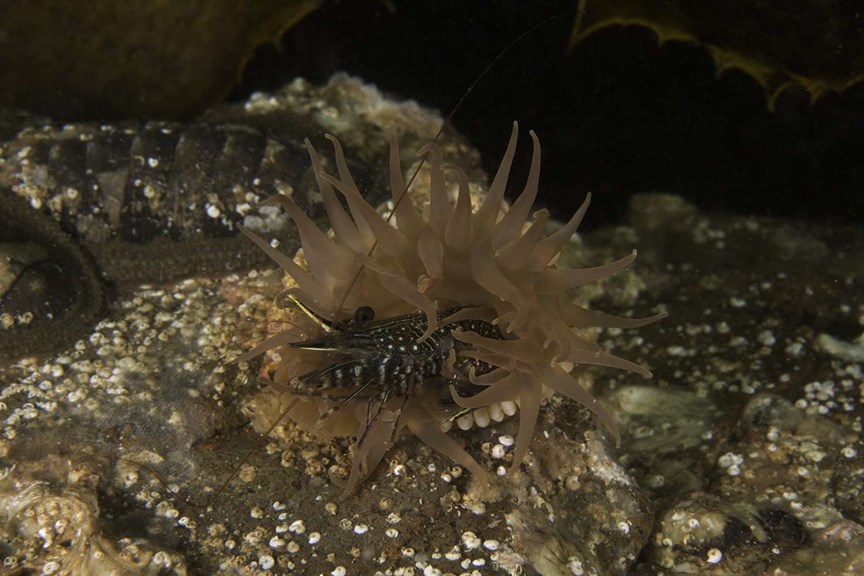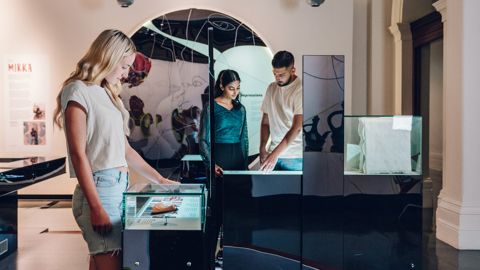Sea anemone feast
What do sea anemones eat?
Sea anemone feast: the everything diet
Sea anemones may look like underwater gardens or aquarium decorations, but they are animals. And if sea anemones are animals, what are they feeding on?
Essentially, sea anemones try and eat anything and everything they can.
At least, that’s what we know for now—the diets of many sea anemones remain a mystery.
But an unsuspecting fish nibbling at the surrounding coral, motes of miniature algae drifting languidly in the current, a curious sea snail in the wrong place at the wrong time ... it seems no one is safe.
As far as we know, sea anemones will take any opportunity—hence why they’re called ‘opportunistic feeders.’
‘They have been recorded to have eaten flying ants that have flown off course over the ocean, large crabs, sea-pens and fish, and they aren’t afraid to take on items bigger than themselves, even birds,’ explains Dr Michela Mitchell, Museums Victoria research associate and sea anemone taxonomist and toxinologist at the Toxinology Department, Women’s and Children’s Hospital, Adelaide.
Hungry sea anemones help the whole reef
Dr Julian Finn, senior curator of marine invertebrates at Museums Victoria, photographed this sea anemone taking on a shrimp feast to rival that of an Aussie BBQ:
But while this shrimp may not appreciate being the main course, the entire reef benefits from a sea anemone chowing down on a good meal.
Living everywhere from the intertidal flats to the deep sea of the Antarctic but feeding from the open water, sea anemones form a link between these two marine ecosystems. This movement of nutrients by organisms is key for a thriving underwater landscape.
Though we’re not sure the unlucky shrimp would agree.
How do sea anemones eat?
Sea anemones use venom to catch food. They are from a group of animals called cnidarians, which include coral and jellyfish. And if there’s one thing that jellyfish are famous for, it’s their sting.
But how do sea anemones sting?
Like jellyfish, sea anemones have tentacles. Sea anemone tentacles are covered in stinging cells called nematocysts, which lie in wait like tiny harpoons.
When an animal passes by a sea anemone, thousands of the barbed stingers discharge and deliver venom.
Subdued and entangled, the helpless prey is pulled by stinging tentacles towards the sea anemone’s waiting mouth.
Eager for its meal, the sea anemone extrudes its mouth and throat (actinopharynx) over the prey, sometimes completely enclosing it before crushing and digesting the food in its throat. The sea anemone’s throat also acts as the gullet.
But if food goes in, waste must come out, right?
For the sea anemone, food goes out the same way it goes in: the sea anemone’s mouth.
Sea anemones feed by forming friendships
If feeding is opportunistic, what happens when there’s no food around?
Some sea anemones have formed close relationships with microscopic algae that give them a helping hand. Like in corals, these microscopic algae—called zooxanthellae—live in the cells of sea anemones.
The zooxanthellae use the sunlight to photosynthesise, sharing their nutrients with their anemone host.
When two species benefit from each other in this way, it’s called mutualism. And while sea anemones will try and eat almost anything that floats by, they do form other mutualistic relationships with potential food sources, like fish.
Some sea anemones are famous for forming mutualistic relationships with the 30 species of clownfish—yes, just like Nemo.
But why didn’t the sea anemone sting and eat Nemo? Clownfish have a secret defence: their mucous coating protects them from the sea anemone’s sharp sting.
For clownfish, their sea anemone associates protect them from predators, whilst the sea anemone’s own predators are chased away by the clownfish.
The sea anemone can even receive nitrogen from the clownfish waste, adding another snack onto the sea anemone menu.
With their firm friendships and ability to perfectly snare their prey, sea anemones are incredible, beautiful creatures that have flourished on this planet for 700 million years and are vital for a thriving underwater community rich with life.
Discover a world 4 billion years in the making. Visit the Our Wondrous Planet exhibition at Melbourne Museum and experience the incredible connections that unite all life on Earth.












